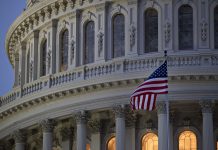 The government’s new crackdown on chronically late flights leaves airlines with little reason to be concerned – and delayed travelers little reason to feel hopeful they’ll arrive on time. The rule, announced days before the holiday travel rush, defines chronic tardiness so narrowly that it would have applied to only 55 recurring flights out of the 13,981 that qualified from January to November, according to an analysis by the aviation data research firm FlightCaster for The Associated Press. All 55 flights were to or from the New York City area’s three airports.That’s unlikely to provide much relief to passengers who just want to get from Point A to Point B on time. Even the few airlines that are at risk of violating the rule can escape the up to $27,500 fine by adjusting their schedules or canceling flights.
The government’s new crackdown on chronically late flights leaves airlines with little reason to be concerned – and delayed travelers little reason to feel hopeful they’ll arrive on time. The rule, announced days before the holiday travel rush, defines chronic tardiness so narrowly that it would have applied to only 55 recurring flights out of the 13,981 that qualified from January to November, according to an analysis by the aviation data research firm FlightCaster for The Associated Press. All 55 flights were to or from the New York City area’s three airports.That’s unlikely to provide much relief to passengers who just want to get from Point A to Point B on time. Even the few airlines that are at risk of violating the rule can escape the up to $27,500 fine by adjusting their schedules or canceling flights.
Transportation Secretary Ray LaHood announced the rule Dec. 21 as part of what he called President Barack Obama’s “Passenger Bill of Rights.” Besides cracking down on chronically late flights, the Transportation Department also said it will impose stiff fines on airlines that trap passengers on tarmacs for more than three hours. The rules, which don’t require congressional approval, take effect in April.
Air travelers regularly cite on-time performance as the most important factor in their perception of airline quality. In a world of tight connections and fewer flights overall, a few minutes can be the difference between getting to a meeting on time or spending the night at a dingy airport motel.
The largest U.S. airlines have had to publish their on-time data every month for more than 20 years. Aside from bad publicity and fuming customers, there’s no penalty for being late.
In those reports, a flight is considered late if it arrives 15 minutes later than its scheduled time. For regularly scheduled flights, that happened about 19 percent of the time during the first 11 months of 2009, or on 521,143 individual flights out of 2.76 million.
With last month’s rule, the DOT created a new definition for “chronically late.” Flights that operate at least 10 times a month are only chronically late if they arrive at their destination more than 30 minutes after their scheduled arrival time more than half the time. And the delays must occur for more than four straight months before the airline risks a fine.
The FlightCaster analysis showed only a handful of flights each month met that threshold.
Continental Airlines Flight 1150, for example, operated nearly every day between Atlanta and Newark, N.J. last year. It was 31 minutes to nearly four hours late, or canceled, more than half the time it flew from January to April 2009. The flight operated nearly every day during a busy time for airport traffic – the 4 p.m. hour. Airport and scheduling issues played into the delays. Continental declined to comment.
But anyone who flew Pinnacle Airlines Flight 3743 from Louisville to Minneapolis in October probably felt just as “chronically delayed” as the Continental passengers. Yet that flight would not fall under the Transportation Department’s rule.
The Pinnacle flight was at least 15 minutes late – or canceled – on 17 of 31 days that month. It was 30 minutes late or more, or canceled, on only 14 of those days – fewer than half the flights. And even if it had met that threshold, Pinnacle would have to repeat its dismal performance for more than another three months. The airline blamed runway construction in Minneapolis and the weather in both cities.
In a statement, the Transportation Department said it chose 30 minutes for the new rule because it’s a significant amount of time. Such delays can result in missed connections and other problems.
The Transportation Department has not studied how many flights would have been affected in 2009, said agency spokesman Bill Mosley. About 60 flights could have violated the rule if it was in effect in 2008, he said.
Mosley also pointed to another rule that would prohibit “unrealistic scheduling not involving chronic delays.” But there is no definition of what that means, and the department doesn’t say if it would definitely fine a carrier for doing that.
Even if airlines have a chronically delayed flight under the new rule, there are still ways of getting around it. Airlines can fix the few flights that could violate the rule by padding their schedules – adding minutes to the scheduled length of the flights so they are logged as on-time.
That will happen more often than canceling flights because under the new rule cancellations count against airlines in the chronically delayed calculation, said travel expert Joe Brancatelli.
“You just build in extra time,” said Richard Magurno, AirTran Airways’ general counsel.
{The Washington Times/Noam Amdurski-Matzav.com Newscenter}











